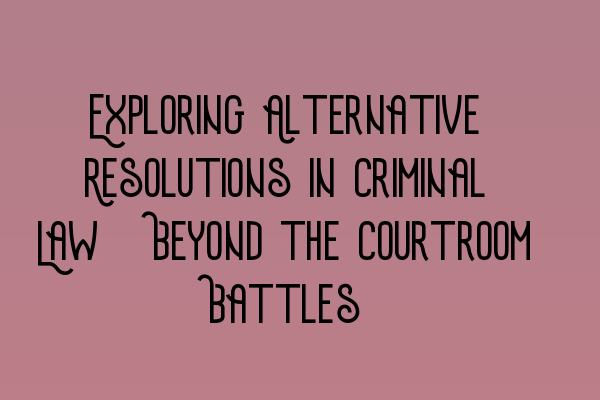Exploring Alternative Resolutions in Criminal Law: Beyond the Courtroom Battles
When it comes to criminal law, the traditional image that comes to mind is a courtroom drama, with lawyers passionately arguing their cases before a judge and jury. While courtroom battles have their place in the legal system, there is a growing recognition of the importance of exploring alternative resolutions in criminal cases. This blog post will delve into the concept of alternative resolutions, their benefits, and how they can provide a more holistic approach to justice.
Understanding Alternative Resolutions
Alternative resolutions refer to methods of resolving criminal cases outside of the traditional courtroom setting. Rather than solely focusing on punishment, alternative resolutions aim to address the underlying issues and seek solutions that benefit all parties involved. These resolutions may include diversion programs, restorative justice practices, or community-based alternatives.
One popular alternative resolution is the use of diversion programs. These programs offer individuals who have committed a non-violent offense the opportunity to avoid traditional criminal prosecution and instead participate in rehabilitative programs. By addressing the root causes of the behavior, such as substance abuse or mental health issues, diversion programs seek to reduce the likelihood of re-offending and provide individuals with a chance to rebuild their lives.
Another alternative resolution gaining traction is restorative justice. This approach involves bringing together offenders, victims, and their communities in a facilitated dialogue. The aim is to repair the harm caused by the crime and promote healing and understanding. By giving victims a voice and allowing offenders to take responsibility for their actions, restorative justice can lead to more integral resolutions that address the needs of all parties involved.
The Benefits of Alternative Resolutions
Alternative resolutions offer several benefits over traditional courtroom battles. Firstly, they can save time and resources. Court proceedings can be lengthy and costly, while alternative resolutions can often be resolved more efficiently. This benefits everyone involved, including the criminal justice system itself.
Furthermore, alternative resolutions can lead to better outcomes for all parties. By addressing the underlying issues that may have contributed to the criminal behavior, these resolutions can help individuals break the cycle of crime and find a path towards rehabilitation and reintegration into society.
Additionally, alternative resolutions promote a more victim-centered approach to justice. Traditional courtroom battles often focus solely on the punishment of the offender, leaving victims feeling unheard and their needs unaddressed. Alternative resolutions provide victims with a voice and an opportunity to participate in the resolution process, allowing for a more holistic and healing approach.
Implementing Alternative Resolutions
While alternative resolutions are gaining recognition, their implementation still faces challenges. One of the major obstacles is the lack of awareness and understanding surrounding these methods. It is crucial for legal professionals, including solicitors and barristers, to stay informed about alternative resolution options, so they can provide comprehensive advice to their clients.
Furthermore, legal systems and institutions need to embrace alternative resolutions and provide the necessary support for their implementation. This includes the provision of adequate resources, training, and infrastructure to effectively implement and monitor these alternative resolution programs.
If you are interested in learning more about alternative resolutions and their role in criminal law, check out our related articles:
- SQE 1 Practice Exam Questions
- SQE 1 Practice Mocks FLK1 FLK2
- SQE 2 Preparation Courses
- SQE 1 Preparation Courses
- SRA SQE Exam Dates
As legal professionals, it is our responsibility to explore alternative resolutions and advocate for a more comprehensive approach to justice. By embracing these methods, we can strive for better outcomes and contribute to a more equitable and rehabilitative criminal justice system.
